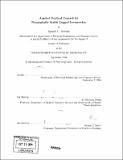Applied optimal control for dynamically stable legged locomotion
Author(s)
Tedrake, Russell L., 1977-
DownloadFull printable version (8.624Mb)
Other Contributors
Massachusetts Institute of Technology. Dept. of Electrical Engineering and Computer Science.
Advisor
H. Sebastian Seung.
Terms of use
Metadata
Show full item recordAbstract
Online learning and controller adaptation will be an essential component for legged robots in the next few years as they begin to leave the laboratory setting and join our world. I present the first example of a learning system which is able to quickly and reliably acquire a robust feedback control policy for 3D dynamic bipedal walking from a blank slate using only trials implemented on the physical robot. The robot begins walking within a minute and learning converges in approximately 20 minutes. The learning works quickly enough that the robot is able to continually adapt to the terrain as it walks. This success can be attributed in part to the mechanics of our robot, which is capable of stable walking down a small ramp even when the computer is turned off. In this thesis, I analyze the dynamics of passive dynamic walking, starting with reduced planar models and working up to experiments on our real robot. I describe, in detail, the actor-critic reinforcement learning algorithm that is implemented on the return map dynamics of the biped. Finally, I address issues of scaling and controller augmentation using tools from optimal control theory and a simulation of a planar one-leg hopping robot. These learning results provide a starting point for the production of robust and energy efficient walking and running robots that work well initially, and continue to improve with experience.
Description
Thesis (Ph. D.)--Massachusetts Institute of Technology, Dept. of Electrical Engineering and Computer Science, 2004. Includes bibliographical references (p. 79-84).
Date issued
2004Department
Massachusetts Institute of Technology. Department of Electrical Engineering and Computer SciencePublisher
Massachusetts Institute of Technology
Keywords
Electrical Engineering and Computer Science.